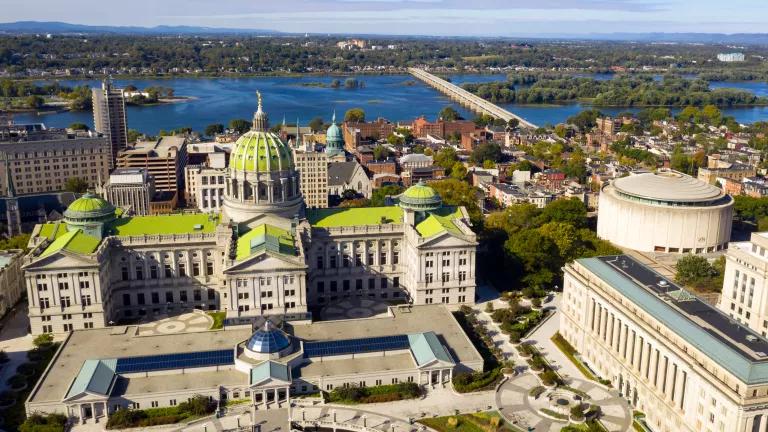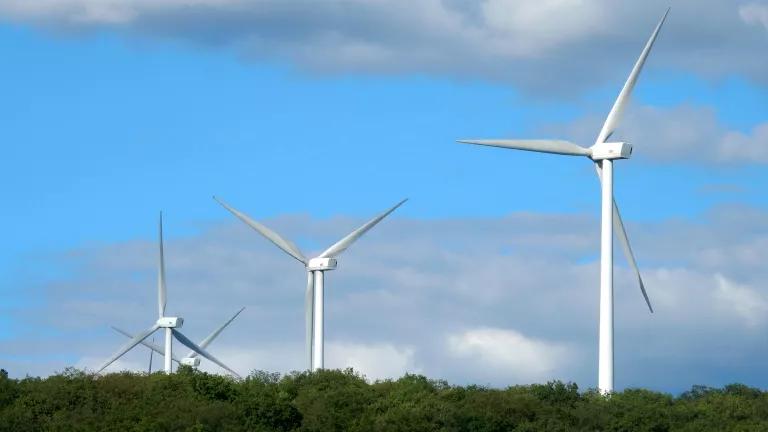
Part of NRDC's Year-End Series Reviewing 2019 Climate & Clean Energy Developments

September

PUC Updates Policy on Energy Assistance Programs
On September 19, the PUC approved significant changes to its Customer Assistance Program (CAP) policy statement and initiated a rulemaking to ensure that electric and gas utilities' energy affordability programs "effectively and efficiently assist low-income ratepayers."
CAPs are among several "universal service" programs that utilities are required to run to help low-income Pennsylvanians maintain utility service. These programs are important because 13 percent of Pennsylvania households live in poverty, while another 24 percent are what the United Way describes as Asset Limited, Income Constrained, Employed, or "ALICE" households. Many Pennsylvanians in both groups face high "energy burdens" - i.e., they spend a high percentage of their household income on energy bills. Energy efficiency programs are a critical tool to reduce these burdens and cut emissions, especially in multi-family housing (a focus of the Energy Efficiency for All coalition). But financial assistance programs are needed too.
The PUC's new CAP policy urges utilities to lower the energy burden thresholds they use to determine eligibility for CAP assistance, a change that will enable more low-income households to participate in these programs. The statement urges utilities to collect some of the new program costs from large industrial and commercial customers. (Pennsylvania is the state where other residential customers generally pay all the costs). The utilities have asked the PUC to reconsider its decision.
The House Passes a Bad Electric Vehicle Fee Bill
As Consumer Reports discusses in a recent analysis, a number of U.S. states have imposed punitive fees on electric vehicles. Of the 26 states that have EV fees, the analysis found, 11 charge EV owners more than owners of similar gas-powered cars pay in gas taxes, and three states charge more than twice that amount.
On September 19, the state House of Representatives passed HB 1392, a bill that would give Pennsylvania the highest EV fee in the nation: $250 per year. As my colleague Kathy Harris and I discussed here, HB 1392 (which was subsequently referred to the House Appropriations Committee) grapples with two very real problems: first, that Pennsylvania's policies for funding transportation infrastructure are deeply dysfunctional, and second, that the current state law requiring "alternative fuel" vehicles to pay taxes in lieu of gas taxes isn't working. Unfortunately, HB 1392 would do almost nothing to solve the first problem, would only partially fix the second, and would discourage EV adoption when we need to do everything we can to encourage it.
As my colleague Max Baumhefner has explained, there's a better way to ensure that we have enough funding for transportation infrastructure and that EV drivers are paying their fair share: index the gas tax to inflation and consumption, and tax EVs according to their miles-per-gallon-equivalent rating.

October

Governor Wolf Directs DEP to Limit Carbon Pollution From Power Plants
Probably the best climate news in Pennsylvania all year was Governor Wolf's issuance of Executive Order 2019-07 on October 3. It directs the Department of Environmental Protection to develop a regulation under existing state law to cut carbon dioxide pollution from power plants, and to design it to enable Pennsylvania to participate in the Regional Greenhouse Gas Initiative, the northeast U.S.'s successful cap-and-invest program. My blog about the Executive Order and what comes next is here, and NRDC's analysis showing that without such limits, carbon pollution from Pennsylvania power plants will increase is here.
Since October, the DEP has developed a presentation explaining how RGGI would work in Pennsylvania, and two bills (SB 950 and HB 2025) have been introduced in the General Assembly to block the DEP from completing a carbon-limits rule.
Looking forward, the three main questions around RGGI are where the initial cap on carbon pollution be set, how carbon allowances will be allocated to generators, and how Pennsylvania will invest the proceeds of allowance auctions. The answers will determine how effective RGGI is at reducing emissions and how the program's benefits are distributed among Pennsylvanians.
Philadelphia and Pittsburgh Advance Climate Policies
Pennsylvania's two biggest cities both participate in the American Cities Climate Challenge, an initiative to help cities accelerate and expand their clean energy efforts. During the second half of 2019, both took major climate actions.
After enacting a Commercial Property Assessed Clean Energy (C-PACE) ordinance, Philadelphia convened the Climate Collaborative of Greater Philadelphia, a forum for area businesses and other large organizations to share best practices around climate goals, and passed a landmark Building Energy Performance Policy to require owners of large non-residential buildings to certify that their buildings meet certain efficiency standards, and otherwise do "tune-ups" of their energy and water systems. The City estimates that buildings covered by the policy will see energy efficiency improvements of 5-20 percent. Philadelphia also issued a Request for Proposals to recommend how Philadelphia Gas Works can diversify its business model and cut greenhouse gas emissions.
In western Pennsylvania, the City of Pittsburgh passed a law requiring new and renovated city buildings to meet a "net zero" energy standard for energy (i.e., to produce as much energy as they use). Meanwhile, Allegheny County also enacted a C-PACE ordinance, and the Western Pennsylvania Energy Consortium – which the city of Pittsburgh helps anchor – is working toward a new energy supply contract with around 30 large energy customers that will leverage its bulk purchasing power for low-cost energy supply purchases. This will move the city of Pittsburgh toward the goal of 100% renewable energy and 200 megawatts of new local renewables.

November

Clean Transportation Infrastructure Act Passes the Senate
On November 19 the state Senate passed SB 596, the Pennsylvania Clean Transportation Infrastructure Act. SB 596 seeks to jump-start the electric vehicle market in Pennsylvania by requiring a statewide transportation electrification goal and directing electric utilities (PECO, PPL, etc.) to develop plans to help the state meet that goal.
The legislation is important because transportation is the largest source of greenhouse gas pollution in the U.S. and electrification is crucial for cutting emissions. To date, however, some Pennsylvanians have been hesitant to buy EVs because the private sector has been slow to build charging stations during the beginning of the electric vehicle market.
The plans that utilities develop under SB 596 will focus on the more urban parts of the state; however, rural counties can opt in. Once plans are approved by the Public Utility Commission, the utilities will construct charging stations in their service territories to remove a barrier for electric vehicle deployment and help Pennsylvanians feel comfortable buying electric. SB 596 passed in the Senate with a huge bipartisan majority, 43 to 6.
Auditor General Releases Climate Action Audit
On November 13th, Auditor General Eugene DePasquale issued Climate Crisis: the Rising Cost of Inaction, a report focusing on the current and future economic costs of climate change in Pennsylvania, and on the state's efforts to curb and prepare for climate change. "In 2018," the report noted, "climate-related costs to Pennsylvania totaled at least $261 million," including over $125.7 million in infrastructure damage from floods and landslides. "Your tax dollars will increasingly be spent to clean up after such disasters if state government does not step up now and limit our contribution to the climate crisis ... It is a simple fact that every $1 spent on preventing natural disaster damage saves $6 in recovery costs."
The report highlights the large gap between what Pennsylvania is doing now on climate mitigation and adaptation and what it needs to do. For example, while the state Department of Agriculture acknowledges that changing temperatures are increasing problems with pests, the Department "has no comprehensive plan to address how climate change will affect the state’s farm and food industries." The bottom line, DePasquale writes, is that Pennsylvania "lacks coordination and specific plans to reduce greenhouse gas emissions to minimize Pennsylvania’s impact on climate change and to properly create or implement adequate plans to lessen damage caused by extreme weather."

December

EQB Approves Methane Rules for Public Comment
As my colleague Amy Mall wrote last week, 2019 saw several new studies concerning the health, climate, and economic effects of fracking. One, just released by Carnegie Mellon University, found that the economic costs of fracking exceed its benefits. Another found that massive improvements in cutting methane leaks are needed if switching from coal to natural gas for electric power is to have any near-term climate benefit. (We already knew the long-term problems with relying on gas for power).
So it was good news when, on December 17th, the Environmental Quality Board advanced a proposal for new emission rules for already-operational fracking equipment. The DEP estimates that these rules could lower emissions of methane by more than 75,000 tons per year and emissions of health-harming volatile organic compounds by more than 4,400 tons per year. That's not enough to make gas climate-friendly, but it's better than the status quo. Public comment will be accepted for 45 days after the proposal is published in the Pennsylvania Bulletin.
FERC Approves PJM Plan to Punish Clean Energy and Raise Energy Bills
I wish I weren't concluding this blog series with this development, because it's awful – terrible for the environment and consumers alike. It's tremendously important, though. And the story was not covered by a single news outlet in Pennsylvania.
On December 19th the Federal Energy Regulatory Commission, or FERC, approved changes to the "capacity market" run by the PJM Interconnection, the Montgomery-County-based regional transmission organization that manages the high-voltage electricity grid in Pennsylvania, 12 other states, and the District of Columbia. The changes will force consumers to pay more money to gas- and coal-fired power plants and make state clean energy programs more expensive.
PJM's capacity market pays generators to be available to produce electricity three years ahead of time. The goal is reliability, i.e., guaranteeing that power supply will always meet demand. But as my colleague Amanda Levin and former colleague Miles Farmer explain here, the PJM capacity market has become a disaster for both the climate and consumers, forcing electricity customers to pay billions of dollars for unneeded gas plants. The changes approved by FERC will make things worse.
Given the fact that PJM is located in Pennsylvania, the media silence about this story is baffling. That is, unless you consider that no one in Pennsylvania made a public statement about it except for NRDC and PJM (which said as little as possible) And remember that the world of energy markets is incredibly recondite, and capacity charges invisible to Pennsylvania electricity consumers. (They're rolled into the "generation" or "generation and transmission" part of the bill).
In January, 2020, PJM will get a new CEO, Manu Asthana. We're hopeful that he will lead PJM in a better direction. But will anyone in Pennsylvania be paying attention?




